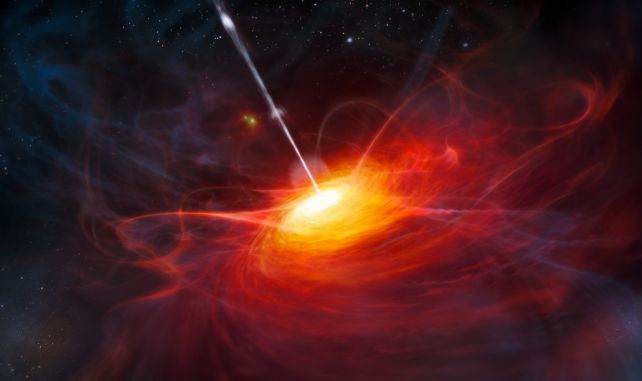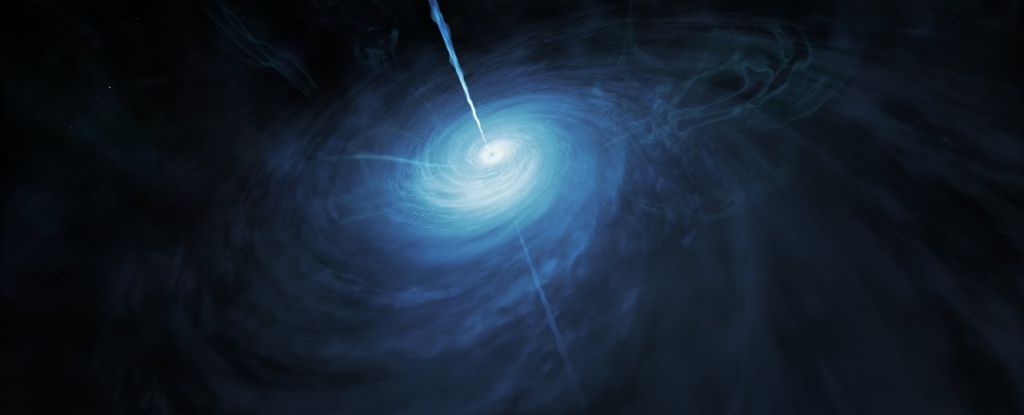Products You May Like
Because of a peculiar effect velocity has on the appearance of the passage of time, our observations make it seem like time ran slower when the Universe was just a baby.
At least, that’s how it appears to us, at a light travel time of nearly 13 billion years away. This is called time dilation, and astrophysicist Geraint Lewis of the University of Sydney in Australia and statistician Brendon Brewer of the University of Auckland have seen it in the early Universe for the first time by studying the fluctuations of bright galaxies called quasar galaxies during the Cosmic Dawn.
Because of accelerating expansion of the Universe, they have found, we see those fluctuations unfold at a rate five times slower than if they were occurring nearby.
It’s the most distant we’ve ever seen time dilation in action, and it solves several problems. It shows that quasars are consistent with the effect over vast gulfs of space-time, which means not only are they in agreement with the standard model of cosmology, we can take time dilation into account in studies of their behavior.

“Looking back to a time when the Universe was just over a billion years old, we see time appearing to flow five times slower,” Lewis explains.
“If you were there, in this infant Universe, one second would seem like one second – but from our position, more than 12 billion years into the future, that early time appears to drag.”
Although it’s not really noticeable in our day-to-day lives, space and time in the Universe are inextricably linked. This is how we can see the accelerating expansion of the Universe. Light from much farther distances stretches as space expands, shifting towards longer, redder wavelengths the larger the distance the source.
This effect is called the Doppler effect, and it can be experienced here on Earth, too. Think of the way an ambulance siren sound seems to stretch out as the ambulance drives away from you.
In this analogy, the ambulance becomes a distant galaxy, and the light is the siren. At the source, the emission is normal, but from our perspective, it becomes all stretched out.
Something similar should – and does – happen to time, as we’ve seen in supernova explosions about halfway across the observable Universe.
Time passes normally to us. To someone hanging out near the supernova explosion, time would appear to also pass normally. But because of the relative velocity between the two points, the supernova appears, to us, to occur in slow-motion.
It’s been predicted that quasars in the early Universe should show a similar effect, but they are different kinds of objects from supernovae. Quasar galaxies are those that have an actively feeding supermassive black hole in their center. The feeding process produces a great deal of light as the material around the black hole heats up, flickering with turbulence.
“Where supernovae act like a single flash of light, making them easier to study, quasars are more complex, like an ongoing firework display,” Lewis says. “What we have done is unravel this firework display, showing that quasars, too, can be used as standard markers of time for the early Universe.”

Lewis and Brewer studied a sample of 190 quasars from between 2.45 and 12.17 billion years ago (the Big Bang took place 13.8 billion years ago), with data across a range of wavelengths taken over a time period of two decades. They had around 200 observations for each quasar, allowing detailed reconstructions of their fluctuations.
Previously, scientists had thought that quasar variability did not show the effects of time dilation, but the samples were small, and observed over a much shorter time period.
By dramatically expanding both the number of quasars, and the duration of observations, the two researchers found that they do appear to flicker in slow motion, compared to more recent quasars.
“Earlier studies led people to question whether quasars are truly cosmological objects, or even if the idea of expanding space is correct,” Lewis says. “With these new data and analysis, however, we’ve been able to find the elusive tick of the quasars and they behave just as Einstein’s relativity predicts.”
The research has been published in Nature Astronomy.
